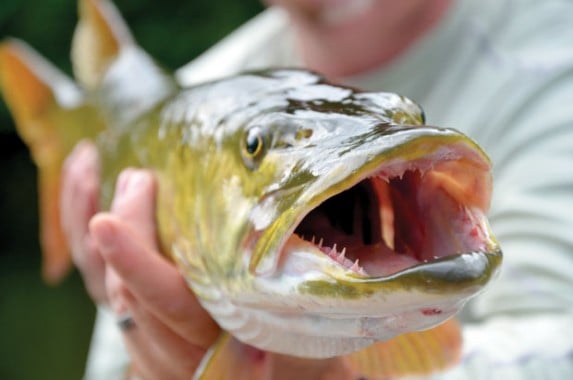The musky is the heavy metal of flyfishing.
“It’s a badass fish,” says fly fishing guide Matt Miles. “They’re mean. They’re extremely tough to catch. They’re almost impossible to figure out. They’ll scare you half to death when they eat. I’ve seen a 38-incher come out of the water three of four times during a fight.”
Known for small stream and wild brook trout, the Blue Ridge is certainly a strange place to find a game fish that can reach upwards of four feet. Musky are closely related to northern pike and are native to the upper Midwest and Great Lakes region. The federal government began stocking Virginia rivers with musky in the 1930s, but the state did not begin managing the population in earnest until 2000. Changes in the stocking strategy have allowed musky populations to thrive in Virginia, especially on the New and James rivers.
Joe Williams, a fisheries biologist for the Virginia Department of Game and Inland Fisheries, has been managing the musky population in the New River and small lakes of southwest Virginia for the past 20 years. He said musky are reproducing naturally on both the James and New, prompting him to decrease his stocking numbers by nearly 80 percent.
“The musky is more of a cool water fish,” he said. “They’re not native to Virginia, but they do well here. We’ve got a lot of cooler water creeks and springs that feed the [New] River so they thrive out there.”
Miles has seen this boom first-hand. Originally from Lynchburg, Va., he moved to Colorado to become a fishing guide before returning to his native waters and starting his own guide service (mattmilesflyfishing.com). He puts clients on trout, smallmouth bass and land-locked stripers, but musky have held a special place in his heart since he first caught one on the fly.
“I made maybe 50 casts and the fish didn’t follow,” he recalled. “Instead, he came directly off the bottom and out of nowhere. The fish literally ate the fly five feet from the boat. I had actually turned my head to say something to my buddy rowing and I just caught the flash out of the corner of my eye and was able to set the hook.”
One is immediately shocked at their size: who wouldn’t want to fight a 40-pound fish on a fly rod? But that is not the only thing that draws anglers to go after musky. They are as elusive as they are menacing, a challenge all too familiar to the fly fisherman.
“They’re mysterious. That’s what drives me to fish for them,” said Miles. “It’s such a challenge, trying to catch one of the hardest fish there is in fresh water.”
Casting for musky on the fly is not your typical outing: it requires the biggest rod you can buy, the biggest fly you can tie, and the heaviest line you can throw. While 12 wt. rods and 10-inch hot pink streamers on sinking line may not appeal to the conventional fly fisherman, they are essential if targeting musky, an activity not for the faint of heart. Musky are notorious for their huge mouths of sharp teeth – they are known to eat ducklings off the water surface – powerful runs and spectacular aerial displays, but what defines this warm water trophy the best may be its erratic behavior. Miles has seen musky attack a fly immediately and without warning, but he has also seen a musky follow a fly all the way to the boat and not eat it.
“I’ve never seen a fish put forth the effort they do and not eat. Never,” he said. “I’ve never seen a fish travel as far as they will following a fly and not eat the damn thing. Trout won’t do it; bass won’t do it. That’s the craziest thing about it.”
This can make fishing for them frustrating, but frustration is not a stranger to the fly fisherman.
“If we were going fishing to catch fish, we would not fly fish. We would do it an easier way. It’s kind of fitting to go after a musky with a fly. It’s kind of the hardest thing you can do.”
Muskie Fishing from Summit Publishing on Vimeo.
Where to Fish
New River
The lower New River in southwest Virginia and West Virginia is the best option for musky in the area. The state record musky was pulled out of these waters in 2007.
James River
The upper James River above Lynchburg is not quite a big a river as the New, but is rapidly gaining a reputation as a musky fishery of equal production.
Shenandoah River
The VDGIF stocks both forks and the main channel of the Shenandoah, adding an intimidating predator lurking just under the surface of one of the East’s most beautiful rivers.
Cave Run Lake
The “Musky Capital of the South” is located just east of Lexington, Ky. and is famous for its large fish and consistent feeding action. The 54-inch state record was caught here in 2008, but you can also fish the tailwaters.
Melton Hill Lake
Part of the Clinch River system in Tennessee, Melton Hill Lake is nearly 5,500 acres of prime predator habitat. The tailwaters are another great option, and a 50-inch limit is a testament to the behemoths that lurk there.







